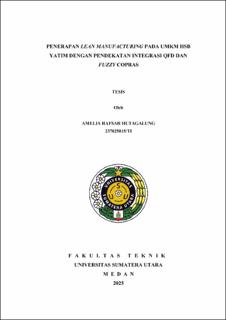| dc.contributor.advisor | Ishak, Aulia | |
| dc.contributor.advisor | Ginting, Rosnani | |
| dc.contributor.author | Hutagalung, Amelia Hafsah | |
| dc.date.accessioned | 2025-06-24T04:53:45Z | |
| dc.date.available | 2025-06-24T04:53:45Z | |
| dc.date.issued | 2025 | |
| dc.identifier.uri | https://repositori.usu.ac.id/handle/123456789/104567 | |
| dc.description.abstract | The garment industry is one of the key sectors where product quality is a crucial aspect to consider. However, over the past few decades, the industry has experienced a decline in quality due to the pressure of fast production in response to high market demand, which has led to compromised quality standards and increased waste in the garment manufacturing process, particularly at the MSME level. This study aims to eliminate waste by selecting appropriate strategies and improving efficiency in the production process of alma mater blazers at HSB Yatim MSME. Therefore, the implementation of lean manufacturing is required as a solution through three stages: identifying waste, selecting appropriate lean tools using the integration of Quality Function Deployment (QFD) and Fuzzy COPRAS, and implementing the selected lean tools along with mapping the value stream.The research findings identified waste in the form of scrap, overprocessing, motion, and rework. Based on the integration of QFD and Fuzzy COPRAS, the recommended lean tool is the implementation of PDCA to address the waste problems in the production process. The PDCA implementation was carried out through two main approaches: the development of standard operating procedures and the use of jig tools. The application of this method successfully reduced material usage by 6.67% and eliminated scrap, rework, motion, and overprocessing. The production process time of one alma mater suit product or Manufacturing Lead Time (MLT) was also reduced by 335.064 and Process Cycle Effeciency (PCE) increased to 5.12 indicating that the efficiency of the process has been achieved and waste has been eliminated.The design results show that the application of the integration of QFD and Fuzzy COPRAS results in a lean tool proposal, namely the application of PDCA with a decrease in waste and an increase in production efficiency. | en_US |
| dc.language.iso | id | en_US |
| dc.publisher | Universitas Sumatera Utara | en_US |
| dc.subject | Fuzzy COPRAS | en_US |
| dc.subject | Lean Manufacturing | en_US |
| dc.subject | Waste | en_US |
| dc.subject | Quality Function Deployment | en_US |
| dc.title | Penerapan Lean Manufacturing pada UMKM HSB Yatim dengan Pendekatan Integrasi QFD dan Fuzzy COPRAS | en_US |
| dc.title.alternative | Implementation of Lean Manufacturing in HSB UMKM Yatim with QFD and Fuzzy COPRAS Integration Approach | en_US |
| dc.type | Thesis | en_US |
| dc.identifier.nim | NIM237025015 | |
| dc.identifier.nidn | NIDN0020116702 | |
| dc.identifier.nidn | NIDN0021026303 | |
| dc.identifier.kodeprodi | KODEPRODI26101#Teknik Industri | |
| dc.description.pages | 126 Pages | en_US |
| dc.description.type | Tesis Magister | en_US |
| dc.subject.sdgs | SDGs 4. Quality Education | en_US |


